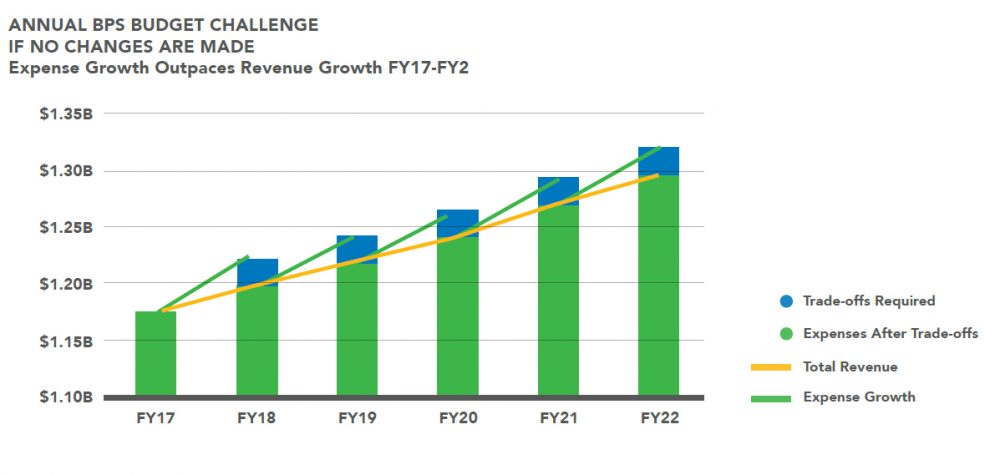Advertisement
BPS Report Proposes '10 Big Ideas' To Close Projected $20-25 Million Budget Gap

A long-term financial report for Boston Public Schools, released Tuesday, projects budget gaps of $20 million to $25 million annually if the district makes no changes in its revenue and expenses.
Notably, the report declares that "Massachusetts' charter school finance model is broken for Boston" and that, if the ballot measure lifting the cap on charters passes, "it would shift the financial landscape so significantly for Boston that this report would need to be revisited."
At a Monday press briefing, the city's budget director, Katie Hammer, referred reporters to Boston Chief Financial Officer Dave Sweeney's finding that passage of the ballot question might force cuts both at BPS and in other city departments.
Eleanor Laurans, BPS chief financial officer, said the district is releasing the report now in order to solicit public input. But she also noted the effect the Question 2 vote could have on the district's long-term financial health.
"Clearly the financial impact on traditional school districts is top of mind as people consider the ballot initiative," Laurans said, "so certainly if the work that we've done can contribute to people's understanding of BPS' fiscal environment, we hope that is a positive."
The long-term finance report focuses on transportation and school buildings in a list of 10 "big ideas" for improving the district's finances. It also looks at teacher salaries and tenure, special education, central office costs and possible lobbying efforts. Taken together, the report argues, these changes could add up to $100 million.
Buses And Buildings
Noting that BPS busing costs are among the nation's highest — and five times the national average — the first three ideas on the list all focus on transportation. Changing the policies on how students are assigned to bus routes, increasing the maximum walking distance from home to bus stop and making routes more efficient could add up to as much as $35 million in savings, the report says.
But some changes could take up to four years to implement; any changes in student assignment involving charter schools, for which BPS currently covers transportation costs, would require approval from the state Legislature. Increasing route efficiency by aligning school start times, particularly if it involved changing charter-school times, would be logistically complex.
"Big idea" No. 4, "Reconfigure the district's footprint," proposes "making adjustments to the number of schools and/or the number of classrooms across schools" and thereby "right-sizing the footprint." The report's authors said, however, that they are not making recommendations about closing schools.
The report does not specify a number of schools that could be affected. It does note that "decisions must be made based on reliable, accurate data that reflects school capacity, student demand, and assessments of equity by neighborhood."
Teacher Salaries And Tenure
Two of the report's ideas would affect teachers, one in salaries and the other in tenure procedures. On tenure, the report notes that a new early hiring process, while giving principals more leeway, is expensive because tenured teachers who do not receive teaching jobs must still be paid (they are also given non-teaching positions); it proposes advocating a change to that state requirement.
On salaries, the report has a couple of suggestions. Saying that the average Boston teacher makes more than national and surrounding districts and that Boston teachers' wages have grown while the national average is flat, the report suggests considering a renegotiation of the rate of growth. It also states that the contractual length of the school day here is shorter than average, and that the school year is one of the shortest in the country; it highlights the costs of paying teachers for extended teaching time and, by implication, suggests renegotiating the amount of that payment.
In special education, the report recommends taking a close look at how students' special needs are classified and which services they are offered. It notes that many services are mandated by state and federal law and states that any changes would be made "through the lens of serving students better and more efficiently."
The report indicates that streamlining central office operations could save $2 million to $4 million a year. But it argues that the central office has always been the first place to look for cuts and therefore is already fairly lean. It does highlight paid administrative leave as one area to examine more closely.
Finally, the report proposes two areas in which BPS could advocate with the state Legislature: giving Boston more flexibility to impose various taxes, and adjusting both the state education funding formula and the charter school assessment.
The report came from the district's Long-Term Financial Plan Advisory Committee, which began working on it in fall 2015 as part of BPS Superintendent Tommy Chang's long-range planning efforts. The district will now seek public comment, both in community meetings and through its website, before the committee gives its final set of recommendations to the Boston School Committee in February 2017.

